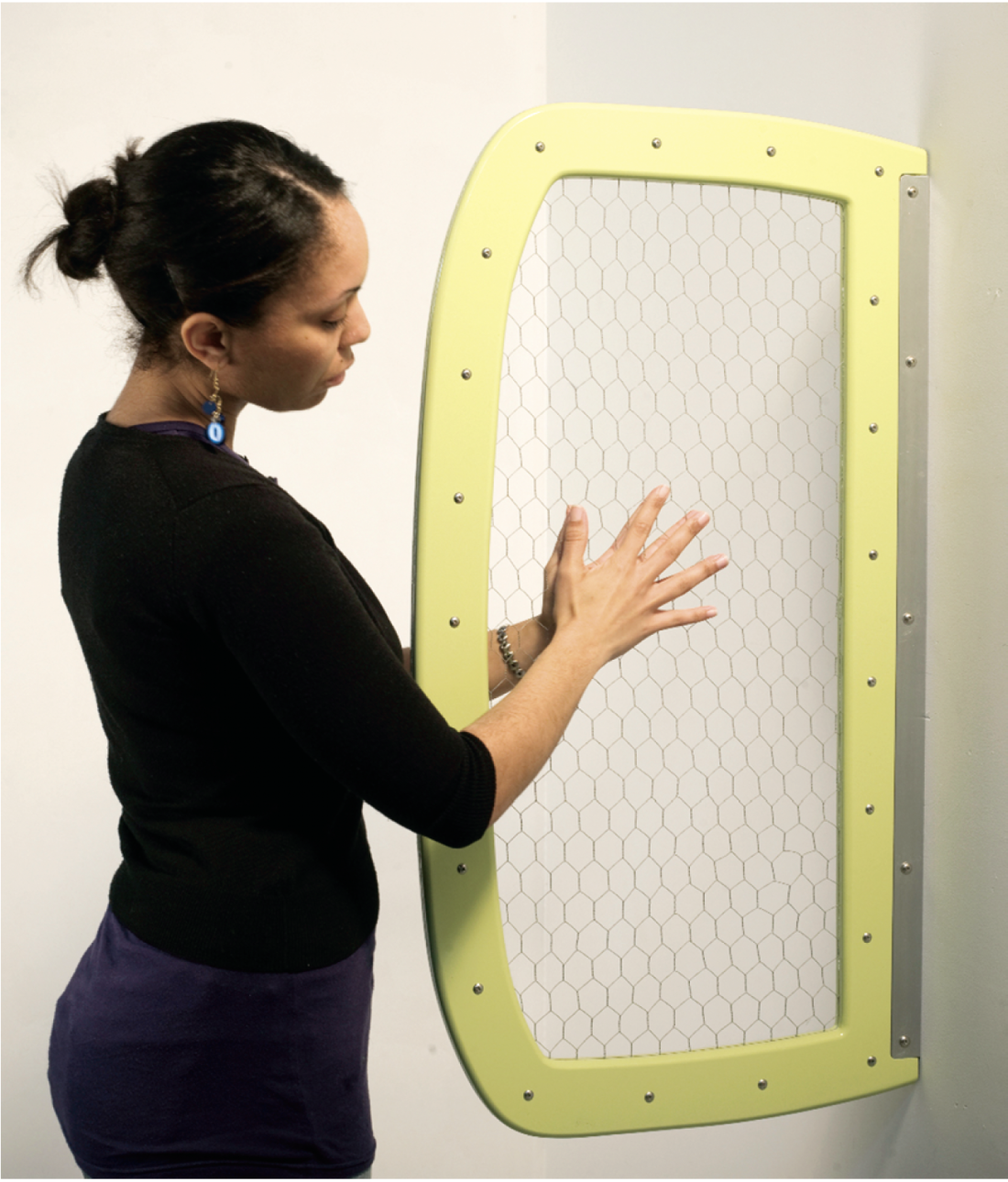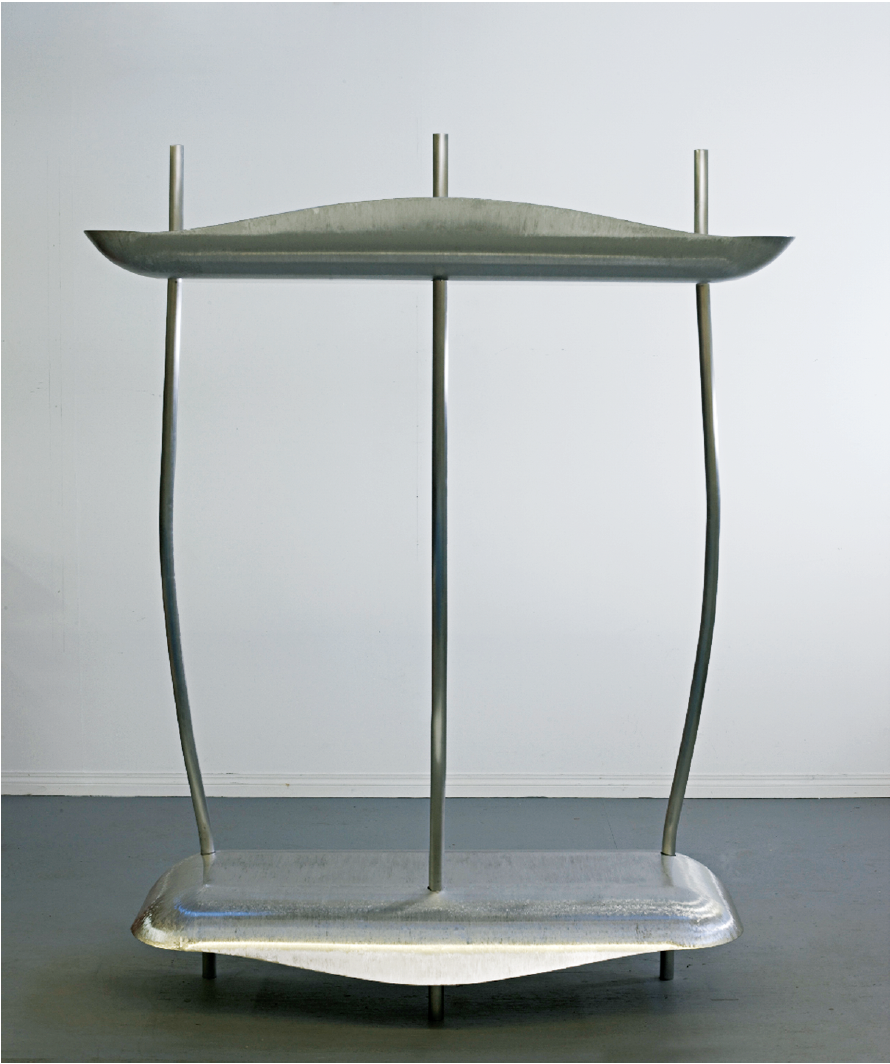Mowry Baden
“Mirroring” is the title of an exhibition of new works by West Coast artist Mowry Baden who has, in this title, used the grammatical form of the gerund to name an activity taking place in the present. A quick look around the gallery reveals that only one of the five pieces includes an actual mirror, while the others involve the theme of symmetry, left/right and above/below. Symmetry in the context of an art gallery alludes to the relationship of a viewing subject confronted by an object “over there,” or a self confronting an other, and it is this convention of immobile, distanced viewing that Baden has been challenging for the past five decades. Baden’s practice is detective work, an activity that includes every visitor’s participation, whether explicit or not, even when it’s non-participation. What is he investigating? It’s art of course—he sets up equipment (sculptures) by which anyone can participate in this in-house activity of art investigating art.
Visiting an exhibition of Mowry Baden’s work inserts the viewer into that complex web of relations that gives us art and non-art. Baden arranges a distinctly performative approach by which viewers enact a multitude of “mirrorings”; for example, what is the material of bodily space? or, am I my thinking mind, while thinking? or, do I see when I see myself seeing while being seen?

Mowry Baden, Septum, 2009, wood, aluminum, stainless steel, 1.2” x 20” x 38”. Photograph: Bob Matheson. Courtesy of Diaz Contemporary, Toronto.
The impression given by a Baden exhibition is that his works cannot be “seen” by being looked at. This observation might seem risky, considering we’re talking about an exhibition of sculpture in an art gallery where the convention is to do precisely this one thing: look at works of art. Perhaps my assertion would seem less unusual if the works in question belonged to the category of conceptual art, but Baden’s work is sculptural; it consists of spatial constructions in bodily relationship with the architecture and viewers. Past commentaries have made much of the physical experientiality of Baden’s work. Its reception has followed a trajectory that most explicitly originates in discussions of minimalist theatricality and an expansion of sculpture. While this path is roughly accurate, it has largely missed the individuality and precision of Baden’s oeuvre.
One of the truly productive insights into Baden’s work is that expressed in curator André Jodoin’s text of Baden’s 1987 Mercer Union exhibition catalogue. Jodoin used the term “testing” to describe an activity he finds central to this artist’s practice. But testing for what? If we describe our contemporary environment as “networked,” then I would suggest we use this as a metaphor to say Baden’s works are for “testing the circuits.” As he frequently professes an interest in the theme of the spectator’s movement, why not extend this to the image of circulation? Baden, with our assistance, is testing the apparatus of circuits and circulation that make up our environment and doing it by way of its alternation with art as art. Or, since these are participatory works, we might say that Baden is providing observers with the equipment to test and explore the circuits on their own. Of course, the point is that the circuits to be tested are those in which the observer/subject is always already disseminated.
While Baden calls his works sculptures, I’m often tempted to argue that, due to their attenuation and dispersal through the regime of art viewing, they are identified with the historical ideals of installation art. And installation works that really go right into the explicit ambitions of early installation work, including, but by no means limited to, the aims of institutional critique. And so, for the viewer, a large part of the work is the opportunity to observe observers engaged in their testing of various aspects of their situation with the aid of Baden’s sculptural device.

Mowry Baden, Upper and Lower Case, aluminum, 80” x 61” x 31”, 2009. Photograph: Bob Matheson. Courtesy of Diaz Contemporary, Toronto.
An example from an earlier Baden exhibition Hudson Street Tomato, 1984, presents us with two possible questions: what is at play when I experience, for example, an exercycle in a conventional-use situation? And secondly, what is at play when I experience that same exercycle with its conventional-use situation “bracketed” and refocused in the contemplative environment we conventionally designate as art? I think the point here is that Baden wants us to consider the circuit in its entirety and in motion: we are not to go on repeating the simplifying interpretation of Duchamp whereby he is accused of showing that an art work can be created by displacing a piece of hardware from its usual situation into the art context. Duchamp’s rotation of the urinal is a helpful point of reference. It was not simply a urinal made into art by separation from its original function; the art is in the rotation, an alternating, reversible motion that has never stopped, never will. The problem with this relationship of art to non-art is that it cannot be done in ways that freeze the figure/ground relation, the inside from the outside. A few ambitious sculptors have made this problem their life’s work, for example, Michael Asher, Lygia Clark or Joseph Beuys.
From the perspective Baden affords, these relations appear to be alternating reversible loops or circuits: mirrorings. How these circuits are to be interpreted will depend to a large degree on the context brought by individual observers; however, since we encounter these equipment-like sculptures in the context of art as art, that will be the guiding factor. What is certain is that, in these circuits, the isolation of any single factor for analytic, distanced regard will arrive at the question of the artwork’s autonomy and it’s possible collapse into the world of everyday life where, discerned and disillusioned, it functions one-sidedly as entertainment or commodity. Baden’s discourse is a discourse on art that weaves through the inside and outside of art: art investigating itself by way of an art and non-art alternation. ❚
“Mirroring” was exhibited at Diaz Contemporary in Toronto from November 19, 2009, to January 9, 2010.
Stephen Horne is an artist and writer based in Montreal.

